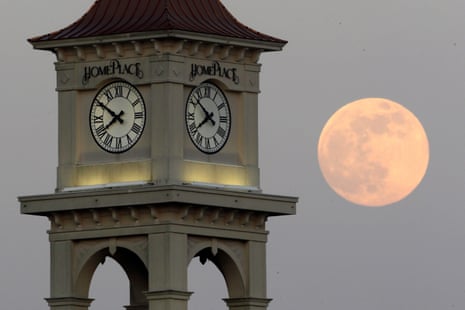The White House wants Nasa to figure out how to tell time on the moon.
A memo sent on Tuesday from the head of the US Office of Science and Technology Policy (OSTP) has asked the space agency to work with other US agencies and international agencies to establish a moon-centric time reference system. Nasa has until the end of 2026 to set up what is being called Coordinated Lunar Time (LTC).
It’s not quite a time zone like those on Earth, but an entire frame of time reference for the moon. Because there’s less gravity on the moon, time there moves a tad more quickly – 58.7 microseconds every day – compared with on Earth. Among other things, LTC would provide a time-keeping benchmark for lunar spacecraft and satellites that require extreme precision for their missions.
“An atomic clock on the moon will tick at a different rate than a clock on Earth,” said Kevin Coggins, Nasa’s top communications and navigation official. “It makes sense that when you go to another body, like the moon or Mars, that each one gets its own heartbeat.”
Nasa has plans to send astronaut missions to the lunar surface beginning in September 2026 through its Artemis program, which will also eventually establish a scientific lunar base that could help set the stage for future missions to Mars. Dozens of companies, spacecraft and countries are involved in the effort.
Without a unified lunar time standard, an OSTP official told Reuters, it would be challenging to ensure that data transfers between spacecraft are secure and that communications among Earth, lunar satellites, bases and astronauts are synchronized.
Discrepancies in time also could lead to errors in mapping and locating positions on or orbiting the moon, the official said.
“Imagine if the world wasn’t syncing their clocks to the same time, how disruptive that might be and how challenging everyday things become,” the official said.
Clocks and time zones on Earth operate on Universal Coordinated Time (UTC), which is internationally recognized. It relies on a vast global network of atomic clocks placed in different locations around the world. They measure changes in the state of atoms and generate an average that ultimately makes up a precise time.
Developing LTC may require atomic clocks to be placed on the moon.
Defining how to implement LTC will require international agreements, the memo said, through “existing standards bodies” and among the 36 nations that have signed a pact called the Artemis accords involving how countries act in space and on the moon. China and Russia, the two main US rivals in space, have not signed the Artemis accords.
UTC might influence how LTC is implemented, the official said. The UN’s International Telecommunication Union defines UTC as an international standard.
The International Space Station, being in low Earth orbit, will continue to use Universal Coordinated Time. But just where the new space time kicks in is something Nasa has to figure out. Even Earth’s time speeds up and slows down, requiring leap seconds.
Unlike on Earth, the moon will not have daylight saving time, Coggins said.
